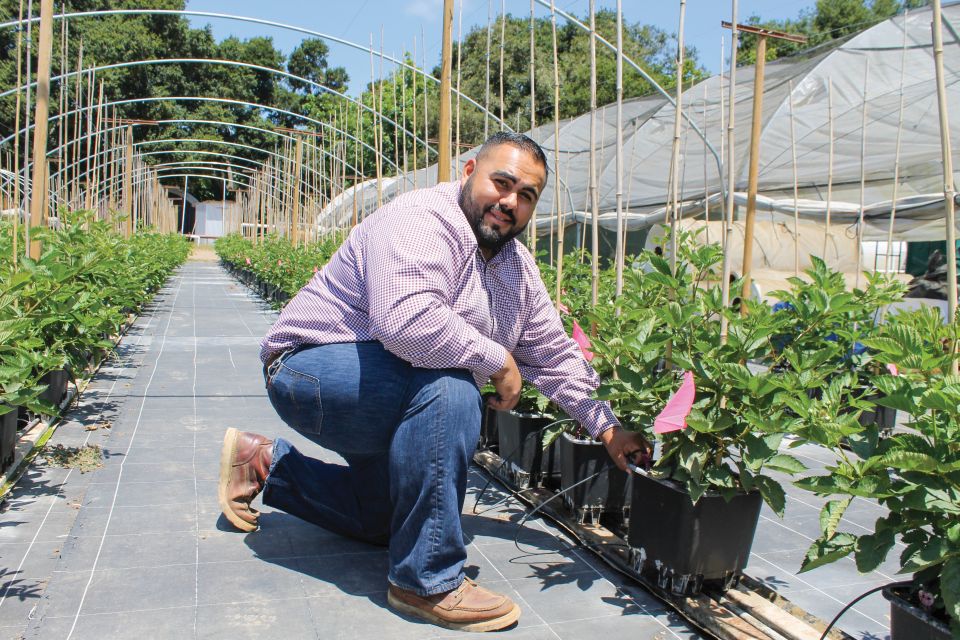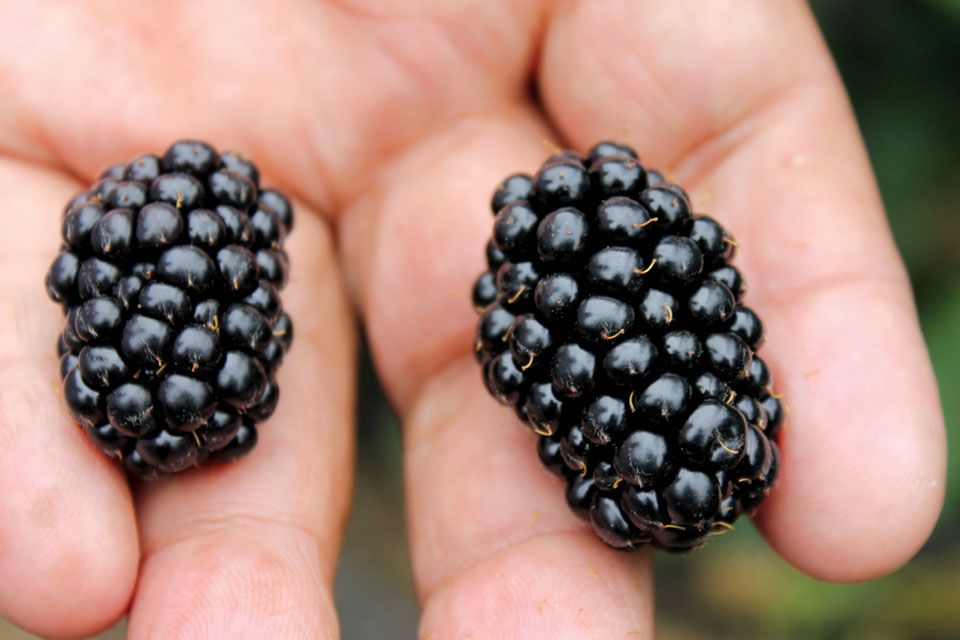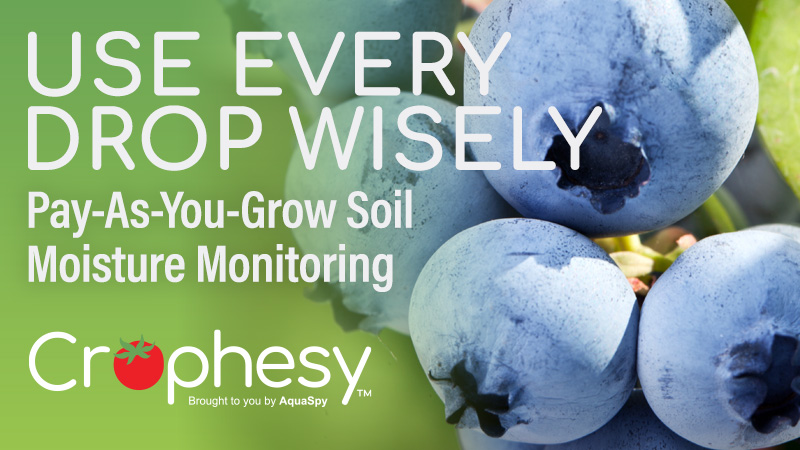Grower Sees Challenges, Opportunities in Booming Organic Berry Market

Jaime Lopez, Reiter Affiliated Companies ranch manager, farms berries on soilless substrate called coir. He says while the cost might be high, there are many advantages to soilless production. (Photo: David Eddy)
It was hard to miss the recent good news for organic growers: Sales of organic fruit up 12.3% over the previous year. Berries, which represented a healthy 14.6% of organic produce sales, saw a 22.1% jump in dollars and 16.6% increase in volume, according to the Organic Produce Network. And while berries as a whole have been on a strong upward trend for some time, organic sales continue to ramp up at even a faster pace than its conventional counterparts.
And now the bad news: Organic berries are extraordinarily difficult to grow. Insects, diseases, and weeds all represent real problems to a berry grower, says Jaime Lopez of Watsonville, CA. Lopez ought to know, as he’s a ranch manager for the largest berry grower in the world, Reiter Affiliated Companies (RAC).
In the 1800s, the Reiter family began farming in the San Francisco Bay Peninsula, and by the 1900s had migrated south into Watsonville and the Santa Clara Valley, where Joseph “Ed” Reiter and R.O “Dick” Driscoll began growing their own ‘Sweetbriar’ strawberries variety. After World War II, they farmed under their respective companies of Reiter and Driscoll’s and began marketing strawberries under the Driscoll Strawberry Associates label with other family and associated suppliers.
Today, RAC grows Driscoll’s proprietary varieties of strawberries, raspberries, blueberries, and blackberries year-round at numerous locations in three U.S. states – California, Oregon, and Florida – as well as Baja California, Central Mexico, Portugal, Morocco, and Peru.
Going Soilless
California’s Central Coast is a great place to grow berries – not too hot, not too cold – but the soils have become a tough place to grow. Besides a whole host of soilborne diseases, microscopic nematodes wreak havoc on tender berry plant roots. Soil problems used to be controlled by methyl bromide, but since the popular fumigant’s phase-out, no drop-in substitute has been found.
Lopez, a RAC ranch manager who farms 80 acres of organic blackberries and 40 acres of organic blueberries in two separate locations, is all too familiar with soilborne problems. And it’s not just the lack of fumigants, but all the regulations, especially those for Telone enacted in 2017 covering growing within five miles of a school. Lopez says he understands the need for pesticide safety, but it is difficult to find good places to grow berries in his area that aren’t within five miles of a school.
Because of that, RAC has chosen to increasingly farm organic berries on soilless substrate, especially a coconut fiber called coir. It’s a lot more expensive than farming in soil – Lopez declines to put a figure on the exact costs – but he hastens to add there are definite advantages. For example, there are many ways to save water with soilless substrate.
You conserve water because it’s essentially a closed system. The water not used by the plants is recycled back to a tank. That’s a huge advantage in a state that regularly encounters droughts. Not only that, but because the water not used by the plants doesn’t go into the water table, he doesn’t have to worry about the fertilizers in the water increasing nitrate levels in ground water, an emerging issue in California.
Besides being a better steward of the land, Lopez says he’s also become a better farmer. You can manipulate the plants better, because fertigating the plants through the irrigation system affords greater control. He can increase yields while at the same time cutting waste.
“I see plants as humans. We want all nutrient levels at optimum all the time,” he says. “If we eat too many hamburgers or donuts, we slow down, we get lazy. Plants will too.”
It’s incredible how much farming has changed just in the past decade since Lopez graduated from high school. When he first started, he was putting on nitrogen because it was that time of season. Now he only does it after examining soil and tissue samples.
“It’s amazing how often we find out we don’t even need more N,” he says. “But we might find out perhaps it needs more micronutrients.”

“I see plants as humans. We want all nutrient levels at optimum all the time. If we eat too many hamburgers or donuts, we slow down, we get lazy. Plants will too,” says Jaime Lopez
Location, Location, Location
The logistics of working with a soilless system are simpler from the get-go. For instance, there’s no need to work the ground to prep it for planting. That means no worries about a rainstorm hitting at planting time – which is done in fall and early winter – and wondering if you’ll be able to get the big tractors out. What the soil is like simply isn’t a factor. There’s no concern about whether it’s loaded with diseases, or if the water table is shallow.
“The ranch might even have lower rent because of those factors,” he says. “It’s very different farming a long-term plant that’s never going to touch the soil.”
By long-term plant, Lopez says that means five years for blackberries. But that doesn’t mean he has no worry about diseases for that entire period. The coir could harbor a disease. However a disease limited to pots is easier to solve than a soil problem, as he simply pulls the plants in question and either sterilizes the pots and coir or puts in new coir. All-in-all, there are fewer things to agonize about.
“You don’t have to worry about a person moving soil in their shoes form one ranch to the other,” he says. “In soilless production or substrate production, it’s much more of a controlled environment.”
Because other factors aren’t as important, the climate – or more accurately, the microclimate – becomes even more vital to consider. He prefers ranches that are up against hillsides where it gets both hotter and colder, as the greater temperature extremes bring up the berries’ Brix. Also, being in a rain shadow usually means greater precipitation.
The Bleeding Edge
While there are a lot of advantages to growing in such a soilless system, it has its challenges. Many of them come from the fact that while such systems have been the norm in parts of Europe for many years, in the U.S. they are still relatively new.
Largely because of the novelty, systems aren’t cheap. Irrigation systems are not made specifically for soilless systems, says Lopez, they are more like specialty items.
In addition, the system requires many more sensors than would a conventional system because the plants’ conditions can vary much more than those rooted in soil.
“We rely a lot on computers – trust but verify. We might have to check on the weekends to make sure everything is OK,” he says. “One little issue with the system and your crop could be destroyed, such as one heat wave without irrigation at the right time.”
Interestingly enough, while Lopez is farming with one of the most high-tech berry growing systems around, his advice on how to be successful rings as true as it has since agriculture has been around: There is no fertilizer like the farmer’s shadow. Of course, in that he is like any good organic grower, constantly walking fields and scouting.
Lopez relies on many different traps to find out what insects and pressure he has. He also relies on trap crops, like planting alfalfa with strawberries. Or being constantly on the lookout for weeds.
“Weeds are super-hard to deal with for an organic grower. You need to pull all of them out before they seed, because if they start a seed bank that‘s awful,” he says. “With this system, it’s concentrating on being preventative more than anything else. In organic, that’s what you need to do.”
That said, Lopez doesn’t favor a cookie-cutter approach. Because these systems are so new, it takes a lot of trial and error to find out what’s best for you.
“For example, one grower likes higher pH and EC than another. At the end of the day they often have same yields and same quality. There’s no right answer there,” he says. “When learning about these systems, take what you’re being taught with a grain of salt. You’ll get better results thinking out of the box.”
Grower Finds His Calling
Jaime Lopez counts himself among the increasing number of younger growers who not only weren’t born into the business of fruit production, they have no background in farming whatsoever, but are now indisputably, irrevocably, hooked on fruit growing.
After high school, the Watsonville, CA resident wanted to learn a vocation, so in 2008 he enrolled in a program to become an automobile technician. He graduated, got a job, but simply didn’t enjoy it. He knew there was a vocation out there for him that was more like an avocation, and he was determined to find it.
Lopez had always liked science, so when a buddy of his, who was taking classes in agriculture at Hartnell Community College in Salinas, encouraged Lopez to join him, it was an easy call. Lopez started with basic ag, soil, and plant science, etc. He knew all about the issue of nitrates – allegedly caused by farmers’ nitrogen fertilizers leaching into groundwater – and soon became fascinated by how growers can be more efficient with nutrients and pesticides.
“What’s the pressure you are facing? Then go from there, and use the minimum crop inputs,” he vividly recalls learning. “It all goes with being a steward of the land.”
Fresh out of Hartnell, he took a job with an irrigation management company, Hortau. Lopez enjoyed it immensely, and naturally found himself at farms belonging to his biggest customers. The largest of these was Reiter Affiliated Companies, the largest berry grower in the world. He found out a scouting position was available at Reiter, and did presentations for some of the company’s ranch managers on fertilizers. He got the job, and was 24 when he started with Reiter.
He worked in fertility and agronomy for a few years, and in his fourth year, he took over an organic strawberry ranch.
“Since then it has been straight farming,” he says with a broad smile. “It doesn’t feel like work; I love being out in the field. There are a lot of challenges – and a lot of ways to solve them.”
Today he’s in charge of two ranches, one with 80 acres of blackberries, and one with 40 acres of blueberries. All 120 acres are farmed organically, which brings even more challenges. That’s fine with Lopez, who has some advice for young people considering career choices.
“When you find something you love,” he says, “it doesn’t feel like work.”

John R. Clark
Ask the Berry Expert: John R. Clark
Editor’s Note: When I first stepped into a blackberry field with Jaime Lopez, he mentioned how critical the work of John Reuben Clark was on primocane-fruiting blackberries. Clark is a distinguished professor of horticulture at the University of Arkansas, and began writing a column for American Fruit Grower® and Western Fruit Grower® magazines earlier this year. He has developed or co-developed 50-plus varieties with a primary emphasis on small fruits. Exactly 20 years ago, Clark selected the first primocane-fruiting blackberries in a seedling field, and introduced the first varieties 13 years ago. I asked Lopez if he had a question for Clark, what would it be?
Lopez: How can we get earlier fruit in primocanes?
Clark: Since the early breeding of primocane blackberries, I noticed different dates of flowering on the first-year canes. This led to variation in fruit ripening. By crossing early blooming parents, the ripening date could be moved earlier. For instance, ‘Prime-Ark Freedom’ on primocanes ripens about two weeks earlier than ‘Prime-Ark 45.’
Newer selections have achieved ripening near one month prior to ‘Prime-Ark 45’ and it is hoped these new generation selections will make it to commercial release, allowing even earlier first harvest. However, the goal of extending blackberry production includes using floricane-fruiting varieties for early to mid-summer harvest, and primocane varieties picking up the season on until to frost or the end of desired harvest, up to 6-7 months in optimum environments. Plus, management of the plants can be a factor.
If primocane-fruiting varieties are allowed to fruit on floricanes, then this can delay the primocane season, potentially two weeks. Plus other management aspects such as time of high tunnel covering can impact flowering date; if plants are encouraged to grow primocanes by providing warmer temperatures in the early season, this should result in earlier harvest date. There is a lot to learn and achieve with this new blackberry technology combining genetics, management, and grower ingenuity.









